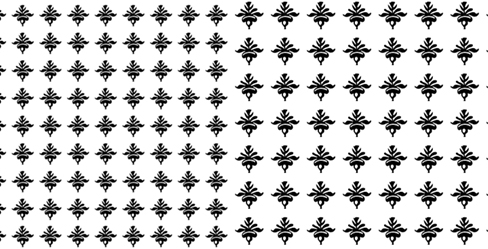Megapixels and perceived detail
Increases in pixel count are often dismissed because to ‘double’ the resolution of a 6 megapixel sensor you would need 24 megapixels. Indeed, to double it linearly you would – but the human eye judges density of detail on an area basis.
It is easy to demonstrate, and I did so a long time ago when people said the 10 megapixels of the A100 was not worth the step up from the 6 megapixels of the Dynax 7D/5D. Here is the diagram I used to show the actual difference:

To the left, you have the density of a 10.2 megapixel sensor, compared to the density of a 6.1 megapixel sensor on the right. In area terms, it’s a 67% increase in the density of textural detail – in the amount of information available for the brain to interpret the image.
The step from 10.2 to 14.2 megapixels is less dramatic – just a 40% increase – but nevertheless significant. The brain can not interpret a flat 2D image as having depth, so we read the same clues that the brain uses in real life alongside stereo vision to judge shape, depth, and movement. The most important monocular clue we process is familiar textural detail, and the way it reduces in scale with distance.
This isn’t new science; it was one of the discoveries of the Renaissance along with other tricks such as aerial perspective (lightening and desaturating of the colours into the distance). It helped great painters to make their flat canvas look three-dimensional.
One of the complaints about early digital photography, and about cameras which processed digital noise too heavily, was that fine textures were lost or quantised (a pixel-frequency based pattern replaced the textures) giving images a ‘plastic’ look and lack of 3D feel.
Just as rollfilm gives more information of this kind than 35mm film, so higher resolution sensors give more information than lower resolution ones. A 14.2 megapixel sensor as found on the Alpha 350 will produce a print with much greater textural information than a 6 or 8 megapixel camera. Depending on the level of smoothing noise reduction, strength of the anti-aliasing filter and other factors (notably lens quality and focus) it may give a better result than a 12 or 10 megapixel camera. It’s very hard to beat a Sony Alpha 100 fitted with a CZ lens for ISO 100 textural information (microcontrast detail)!
But here is how much more you get from a 2008 14.2 megapixel sensor compared to a 2004 6.1 megapixel sensor:
![]()
In real terms, the difference in density is precisely the same as that required to make an A3 print, instead of an A4 print, to a set standard of sharpness and detail. That’s how far we have come between the Konica Minolta 7D and the Sony Alpha 350 – from single page repro to double page spread. Given that double page repro was already possible with care using the 6 megapixel camera (as Photoworld demonstrated) the 14 megapixel camera should be capable of an A2 litho printed poster.
The move to higher pixel densities is not a pointless race. All other things being equal, the higher density image will provide more information to the eye and brain, and yield pictures of the same subjects which look that little bit more realistic.
There is little doubt that the Alpha 350 does not do this ‘out of the box’ when shooting JPEGs as the extended input dynamic range results in a lowering of microcontrast detail, giving the images a slightly flat look despite a decent straight-line section in the transfer curve. The 350 comes into its own when you work from raw files and recover every bit of the available resolution.
– David Kilpatrick
